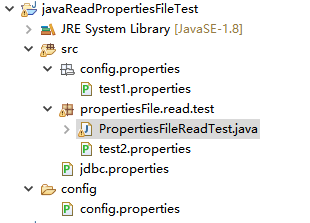一、java读取properties文件总结
在java项目中,操作properties文件是经常要做的,因为很多的配置信息都会写在properties文件中,这里主要是总结使用getResourceAsStream方法和InputStream流去读取properties文件,使用getResourceAsStream方法去读取properties文件时需要特别注意properties文件路径的写法,测试项目如下:

/* 范例名称:java读取properties文件总结
* 源文件名称:PropertiesFileReadTest.java
* 要 点:
* 1. 使用getResourceAsStream方法读取properties文件
* 2. 使用InPutStream流读取properties文件
* 3. 读取properties文件的路径写法问题
*
**/
package propertiesFile.read.test;
import java.io.BufferedInputStream;
import java.io.FileInputStream;
import java.io.FileNotFoundException;
import java.io.IOException;
import java.io.InputStream;
import java.text.MessageFormat;
import java.util.Properties;
public class PropertiesFileReadTest {
public static void main(String[] args) throws FileNotFoundException {
readPropFileByGetResourceAsAtream();
System.out.println("--------------");
//readPropFileByInPutStream();
}
/*
* 使用getResourceAsAtream方法读取
*/
private static void readPropFileByGetResourceAsAtream() {
/*
* 读取src下面config.properties包内的配置文件 test1.properties位于config.properties包内
*/
InputStream inl = PropertiesFileReadTest.class.getClassLoader()
.getResourceAsStream("config/properties/test1.properties");
/*
* 读取和PropertiesFileReadTest类位于同一个包里面的配置文件
* test2.properties和PropertiesFileReadTest类在同一个包内
*/
InputStream in2 = PropertiesFileReadTest.class.getResourceAsStream("test2.properties");
/*
* 读取src根目录下文件的配置文件 jdbc.properties位于src目录
*/
InputStream in3 = PropertiesFileReadTest.class.getClassLoader().getResourceAsStream("jdbc.properties");
/*
* 读取位于另一个source文件夹里面的配置文件 config是一个source文件夹,config.properties位于config
* source文件夹中
*/
InputStream in4 = PropertiesFileReadTest.class.getClassLoader().getResourceAsStream("config.properties");
Properties properties = new Properties();
System.out.println("----使用getResourceAsStream方法读取properties文件----");
// 从输入字节流读取属性列表(键,值)
try {
System.out.println("-----------------------");
properties.load(inl);
System.out.println("test1.properties:name=" + properties.getProperty("name") + ",age="
+ properties.getProperty("age"));
System.out.println("-----------------------");
System.out.println("-----------------------");
properties.load(in2);
System.out.println("test2.properties:name=" + properties.getProperty("name") + ",age="
+ properties.getProperty("age"));
System.out.println("-----------------------");
properties.load(in3);
System.out.println("jdbc.properties:");
// 使用指定的格式字符串和参数返回格式化的字符串, 这里的%s是java String占位符
System.out.println(String.format("jdbc.url=%s", properties.getProperty("jdbc.url")));
System.out.println(String.format("jdbc.usename=%s", properties.getProperty("jdbc.usename")));
System.out.println(String.format("jdbc.password=%s", properties.getProperty("jdbc.password")));
properties.load(in4);
System.out.println("config.properties:");
// 使用给定的模式创建一个MessageFormat,并使用它来格式化给定的参数,{0}是一个java的字符串占位符
System.out.println(MessageFormat.format("dbuser={0}", properties.getProperty("dbuser")));
System.out.println(MessageFormat.format("dbpassword={0}", properties.getProperty("dbpassword")));
System.out.println(MessageFormat.format("database={0}", properties.getProperty("database")));
System.out.println("----------------------------------------------");
} catch (IOException e) {
// TODO Auto-generated catch block
e.printStackTrace();
}finally {
if(inl != null) {
try {
inl.close();
} catch (IOException e) {
e.printStackTrace();
}
}
if(in2 != null) {
try {
inl.close();
} catch (IOException e) {
e.printStackTrace();
}
}
if(in3 != null) {
try {
inl.close();
} catch (IOException e) {
e.printStackTrace();
}
}
if(in4 != null) {
try {
inl.close();
} catch (IOException e) {
e.printStackTrace();
}
}
}
}
/*
* 使用InputStream流读取properties
*/
private static void readPropFileByInPutStream() throws FileNotFoundException {
InputStream in1=null;
InputStream in2=null;
InputStream in3=null;
InputStream in4=null;
System.out.println("----使用InputStream流读取properties文件----");
try {
/*
* 读取src下面config.properties包内的配置文件 test1.properties位于config.properties包内
*/
in1 =new BufferedInputStream(new FileInputStream("src/config/properties/test1.properties"));
/*
* 读取和PropertiesFileReadTest类位于同一个包里面的配置文件
* test2.properties和PropertiesFileReadTest类在同一个包里面
*/
in2=new BufferedInputStream(new FileInputStream("src/propertiesFile/read/test/test2.properties"));
/*
* 读取src根目录下文件的配置文件
* jdbc.properties位于src目录
*/
in3 = new BufferedInputStream(new FileInputStream("src/jdbc.properties"));
/*
* 读取位于另一个source文件夹里面的配置文件
* config是一个source文件夹,config.properties位于config source文件夹中
*/
in4 = new FileInputStream("config/config.properties");
Properties properties=new Properties();
System.out.println("-----------------------");
properties.load(in1);
System.out.println("test1.properties:name=" + properties.getProperty("name") + ",age="
+ properties.getProperty("age"));
System.out.println("-----------------------");
System.out.println("-----------------------");
properties.load(in2);
System.out.println("test2.properties:name=" + properties.getProperty("name") + ",age="
+ properties.getProperty("age"));
System.out.println("-----------------------");
properties.load(in3);
System.out.println("jdbc.properties:");
// 使用指定的格式字符串和参数返回格式化的字符串, 这里的%s是java String占位符
System.out.println(String.format("jdbc.url=%s", properties.getProperty("jdbc.url")));
System.out.println(String.format("jdbc.usename=%s", properties.getProperty("jdbc.usename")));
System.out.println(String.format("jdbc.password=%s", properties.getProperty("jdbc.password")));
properties.load(in4);
System.out.println("config.properties:");
// 使用给定的模式创建一个MessageFormat,并使用它来格式化给定的参数,{0}是一个java的字符串占位符
System.out.println(MessageFormat.format("dbuser={0}", properties.getProperty("dbuser")));
System.out.println(MessageFormat.format("dbpassword={0}", properties.getProperty("dbpassword")));
System.out.println(MessageFormat.format("database={0}", properties.getProperty("database")));
System.out.println("----------------------------------------------");
} catch (IOException e) {
// TODO Auto-generated catch block
e.printStackTrace();
}finally {
if (in1 != null) {
try {
in1.close();
} catch (IOException e) {
e.printStackTrace();
}
}
if (in2 != null) {
try {
in2.close();
} catch (IOException e) {
e.printStackTrace();
}
}
if (in3 != null) {
try {
in3.close();
} catch (IOException e) {
e.printStackTrace();
}
}
if (in4 != null) {
try {
in4.close();
} catch (IOException e) {
e.printStackTrace();
}
}
}
}










